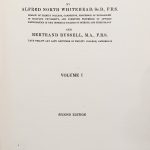FERMAT 1894
- Description
Description
Œuvres de Fermat, publiées par les soins de MM.Paul Tannery et Charles Henry, t. 2-3, Paris, Gauthier-Villars et fils, 1894
Pierre de Fermat (1607 –1665) was a French mathematician who is given credit for early developments that led to infinitesimal calculus, including his technique of adequality. In particular, he is recognized for his discovery of an original method of finding the greatest and the smallest ordinates of curved lines, which is analogous to that of differential calculus, then unknown, and his research into number theory. He made notable contributions to analytic geometry, probability, and optics. He is best known for his Fermat’s principle for light propagation and his Fermat’s Last Theorem in number theory, which he described in a note at the margin of a copy of Diophantus’ Arithmetica.
Fermat was born in 1607 in Beaumont-de-Lomagne, France. He attended the University of Orléans from 1623 and received a bachelor in civil law in 1626, before moving to Bordeaux. In Bordeaux, he began his first serious mathematical researches, and in 1629 he gave a copy of his restoration of Apollonius’s De Locis Planis to one of the mathematicians there. Certainly, in Bordeaux he was in contact with Beaugrand and during this time he produced important work on maxima and minima which he gave to Étienne d’Espagnet who clearly shared mathematical interests with Fermat. There he became much influenced by the work of François Viète.
Fermat’s pioneering work in analytic geometry (Methodus ad disquirendam maximam et minimam et de tangentibus linearum curvarum) was circulated in manuscript form in 1636 (based on results achieved in 1629), predating the publication of Descartes’ famous La géométrie (1637), which exploited the work. This manuscript was published posthumously in 1679 in Varia opera mathematica, as Ad Locos Planos et Solidos Isagoge (Introduction to Plane and Solid Loci).
In Methodus ad disquirendam maximam et minimam and in De tangentibus linearum curvarum, Fermat developed a method (adequality) for determining maxima, minima, and tangents to various curves that was equivalent to differential calculus. In these works, Fermat obtained a technique for finding the centers of gravity of various plane and solid figures, which led to his further work in quadrature.
Fermat was the first person known to have evaluated the integral of general power functions. With his method, he was able to reduce this evaluation to the sum of geometric series. The resulting formula was helpful to Newton, and then Leibniz, when they independently developed the fundamental theorem of calculus.
In number theory, Fermat studied Pell’s equation, perfect numbers, amicable numbers and what would later become Fermat numbers. It was while researching perfect numbers that he discovered Fermat’s little theorem. He invented a factorization method—Fermat’s factorization method—and popularized the proof by infinite descent, which he used to prove Fermat’s right triangle theorem which includes as a corollary Fermat’s Last Theorem for the case n = 4. Fermat developed the two-square theorem, and the polygonal number theorem, which states that each number is a sum of three triangular numbers, four square numbers, five pentagonal numbers, and so on.
Although Fermat claimed to have proven all his arithmetic theorems, few records of his proofs have survived. Many mathematicians, including Gauss, doubted several of his claims, especially given the difficulty of some of the problems and the limited mathematical methods available to Fermat. His famous Last Theorem was first discovered by his son in the margin in his father’s copy of an edition of Diophantus, and included the statement that the margin was too small to include the proof. It seems that he had not written to Marin Mersenne about it. It was first proven in 1994, by Sir Andrew Wiles, using techniques unavailable to Fermat.
Please contact us for more information here






